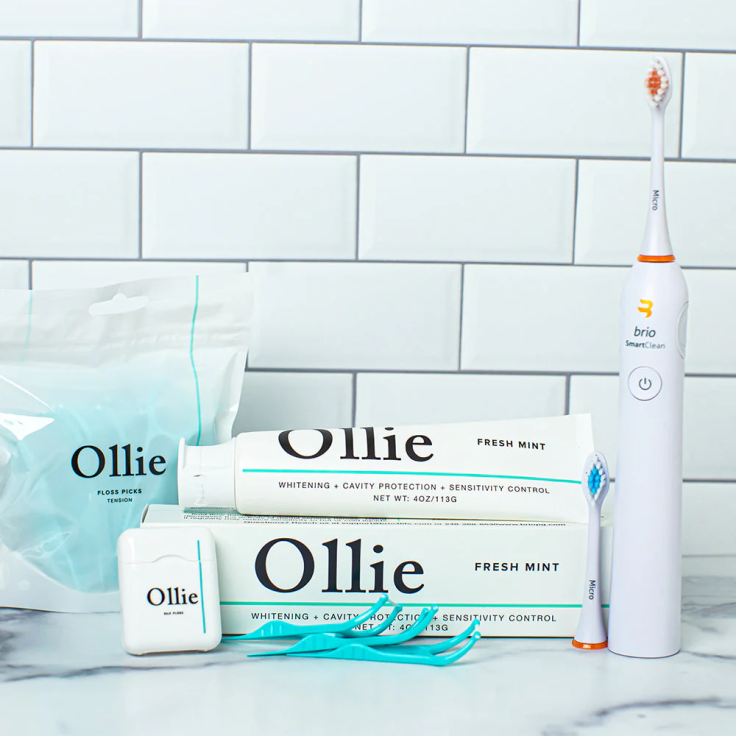Best At-Home Whitening Treatments

A bright and confident smile can work wonders, boosting your self-esteem and leaving a lasting impression. While professional teeth whitening at the dentist's office is a popular option, it can be costly ($300 -$600 per treatment) and result in more sensitivity than other approaches. Advancements in at-home whitening treatments have made achieving that radiant smile more convenient than ever.
Here's the tricky part: There are many options for at-home whitening products. This guide will help you pick the right products to make your whitening process quick and effective.
Surface Stains vs. Intrinsic Stains
You've had the same teeth since you were 10 years old; it's normal for them to have some stains. You don't need to feel bad about this. It's important to know that your teeth can be stained in two different ways, so it takes more than one method to get your teeth shining as brightly as possible.
Surface stains are generally contained in the biofilm that inhabits your mouth and the outer surface of your enamel. The biggest defense against surface stains is the mechanical action of brushing your teeth. For removing surface stains, you should be using a powerful sonic toothbrush twice a day as well as some form of whitening toothpaste.
Using a mildly abrasive toothpaste can help remove stains more quickly. While there have been some toothpaste fads, including charcoal and baking soda, many options can be overly abrasive. Make sure the paste isn't too gritty or that you are not brushing too hard. Excessive grit and pressure can damage enamel, dentin and gum tissue, leading to gum issues and tooth sensitivity — definitely not what you want if you are starting a whitening treatment.
A powerful sonic brush can be more effective than a manual brush at removing stains, especially when used twice a day. There are also whitening toothpastes that include ingredients like potassium nitrate, which can reduce sensitivity, priming your teeth for whitening treatments. If you are doing a good job of brushing twice a day with a sonic brush, that is about all you need to do to ensure that surface stains aren't holding back your whitening process.
Intrinsic stains are stains that are deeper within the enamel of your teeth. It's natural for people's teeth to be different shades, and darker shades don't necessarily mean that your teeth are dirty or unhealthy. Luckily, whitening products are very effective at whitening teeth with darker intrinsic colors.
Peroxide is the industry standard for whitening products and has been proven safe and effective. The hard part comes with picking through all the options for peroxide products.
Choosing the Right Method
While the whitening ingredient may be a simple answer, it's the application method that gets tricky. There are whitening pens, wipe-on gels, mouthwashes, pre-filed trays, LED devices, whitening strips, custom trays, etc.
While most of these may use similar ingredients, there are only two options that actually hold the peroxide in place long enough to be an effective whitening treatment: whitening strips and trays.

All other methods lack the ability to keep the peroxide on your teeth and are wiped off by your lips and saliva shortly after application. The only practical way is to have the formula held against your teeth (and hopefully not on your gums) for the entire duration of the treatment, which is generally 30 to 60 minutes.
With strips and trays emerging as the clear winner when it comes to whitening effectiveness and bang for your buck, we have found that most people find whitening strips to be more comfortable and convenient than using trays. Trays need to be filled with the peroxide formula prior to use, adding an extra step and a lot of extra parts. Trays are also less comfortable than strips, and it is nearly impossible to speak while wearing them. If used outside the home, like on vacation or while driving to work, disposing of whitening strips is much easier than keeping track of trays that need to be reused. Because of this, strips are a bit more convenient and comfortable than trays. Since any whitening routine requires some level of consistent use, whitening strips become more effective because they are generally used more often than less convenient methods.
Other Considerations for Choosing White Strips
While most whitening strips have a similar form, there are a few differences you should consider before deciding which one is right for you.
- Peroxide concentration: The strength varies between brands, generally between 5 and 14% — stronger strips should be worn less frequently and may cause more sensitivity.
- Potassium nitrate: The active ingredient in Sensodyne is proven to reduce sensitivity and is a great ingredient to use during your whitening process. There is even one brand of whitening strips that includes potassium nitrate in the strips.
- Consider the ingredients used: Whitening strips come in different flavors, so make sure that the flavorings are from natural sources such as essential oils.
- Strips should stay in place: Different strips have different levels of stickiness. See what reviewers are saying about how they stay in place.
- Flavor: When something is in your mouth for more than 30 minutes, you will care about how it tastes. Try to find a flavor that will work for you.
Long-lasting Effects
To get the most out of your whitening system, you may need to make slight adjustments to your habits. This could include switching to a sonic toothbrush, brushing more often (or for longer) and regularly using some type of peroxide whitening strip once or twice a week. With some adjustments to your routine, it may not be necessary to make any adjustments to your diet.
Your Journey to a Brighter Smile Starts Today

Achieving a dazzling smile is well within your reach, thanks to the wide array of at-home teeth whitening options available today. Understanding the distinction between surface and intrinsic stains is key to tailoring your whitening strategy for optimal results.
Through diligent brushing with a powerful sonic toothbrush and the use of appropriate whitening toothpaste, you can effectively combat surface stains. For deeper intrinsic stains, peroxide-based products are the gold standard, and choosing the right method for application is crucial. Whitening strips have emerged as the most convenient and comfortable option, offering both efficacy and ease of use.
As you embark on your teeth whitening journey, take note of peroxide concentration, additional ingredients like potassium nitrate for sensitivity reduction, and strip adhesion. Embrace these considerations and, with consistent effort, enjoy the long-lasting effects of a radiant smile that leaves a lasting impression on everyone you meet. Remember, a confident smile is a reflection of your inner vibrance, so let it shine brightly.
Published by Medicaldaily.com



























